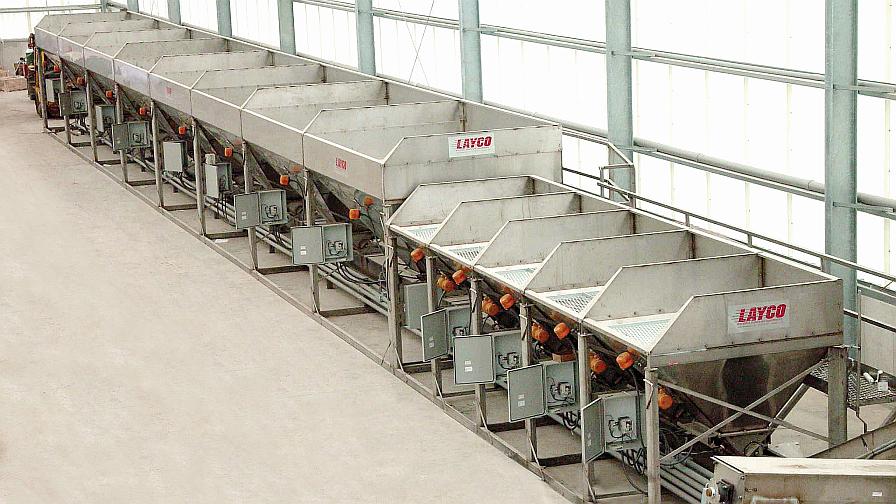Plants Acclimate to Automation

AGI-Yargus’ LAYCO Declining Weight Blending system.
The world of fertilizer plant automation is reportedly seeing a boom in adoption as local product vendors (i.e., crop input retailers) strive to keep abreast of a quite literally growing customer base (average farm size is growing every season, according to USDA)
Conversely, with farm income still down or at best flat in most cases, it’s not entirely realistic to expect ag retailers to just throw money at the problem and hire a bunch of new plant operators to keep pace with today’s customer.
That’s precisely where something like automation enters the picture.
“We see a high percentage of retailers incorporating automation into their blending plants,” shares Charles Formisani, Director of Business Development, Sackett-Waconia. “Automation helps to increase speed and accuracy of the blending system, as well as helps with logistics, billing, and inventory. All this leads to a more lean and efficient operation.”
Nate Reznechek, Sales Director – Fertilizer, Agridry, & Aftermarket, AGCO/GSI Group, Inc., would have to agree.
“A common customer concern I hear about current systems continues to be how to do more with less people,” he explains. “Good employees continue to be hard to find, and application windows aren’t getting longer. Most (retailers) see the value and are willing to make the investment. And remember, not all systems need an expensive, hi-tech solution.”
The Challenge Lies in Choosing
For this piece, a majority of the six industry players we talked to agreed that at the moment the number of options and different systems available to your typical plant manager is temporarily confusing at best and sheer panic-inducing at worst.
“One of the biggest challenges they are facing are the number of solution providers out there,” states Brian Sokoloski, Software Sales, Kahler Automation. “Selecting a provider that is able to offer a solution to a simple system as well as a complex system in a consistent, standard manner can sometimes be difficult. And systems are getting larger every year, it seems.”
Another important aspect for any time-challenged plant manager is a confidence that the machinery and system will perform consistently, especially during the busy season crunch.
“A retail fertilizer plant manager needs to know that when the time comes the automated blender will run flawlessly and provide farmers with a quality blend,” says Josh Woods, Automation Engineer, AGI-Yargus Manufacturing. “The accuracy of the blends need to be spot on because in the precision ag world that we live in today, each acre will have its own NPK analysis and will take the soil to optimal growing levels.”
Meanwhile, Quad Cities, IA-region headquartered AgWorks has witnessed a fundamental shift in how its customers view plant automation software packages, which in turn has caused the outfit to have to shift some of its own strategies around.
“We’ve seen a remarkable change in the conversation about software in the past two years,” says Greg Duhachek, President, AgWorks. “What was once a fairly predictable quest by retailers to seek out better agronomy operations tools, or to contemplate a better accounting system, or perhaps even change their precision tools, now the conversation has moved very strongly into ‘How do we consult and sell to the grower of tomorrow?!’”
Market Offerings
One of many market-facing plant automation offerings for retailers, Junge Control’s Plant Operator Software is reportedly a good fit for operations looking to sync up agronomy and accounting data on one platform, according to Dave Junge, President, Junge Control.
“The Junge Plant Operator software is used to operate the equipment (liquid or dry), and with our Junge Dispatcher, we quite often can bridge the gap between order entry and invoicing, allowing the operators of the blend systems maximum flexibility,” he shares.
Junge says its Dispatcher software is made “operator friendly” with the end-user at the center of the product.
“Not too much complexity on the order entry side, and definitely not too much on the billing side … just the right mix,” Junge says. “The Junge Dispatcher Software fits into these challenging changes very well, and in turn our sales are growing. I believe more cloud solutions will assist in the technology that is upcoming.”
Just as Junge is zeroing in on operator ease of use, so too is Sackett-Waconia.
“We will soon be launching automation upgrades for our Declining Weight blend systems with focus on ‘ease of use’ as well as being easily expandable, configurable and flexible,” Formisani reveals. “We feel Sackett-Waconia is a unique equipment supplier in that we offer a lot of flexibility in terms of automation, both in design and supply.”
Meanwhile, GSI’s Reznechek feels the outfit’s InterSystems brand’s reputation for ingenuity and innovation currently set it apart from many of its competitors in the market.
“When customers invest in our products they know they’re investing in the latest and best technology,” he says.
Asked for an example, Reznechek cites a couple.
“Customers invest in GSI’s Fertilizer equipment because they want speed, high blend quality, flexibility, and robust equipment supported by an American company,” Reznechek states. “We recently replaced a competitor’s blend tower that was less than five years old because it was too slow and didn’t have the design flexibility to meet their current business requirements. At another location the customer asked us to slow down our post-blend discharge rate because they were concerned we might damage the bags on their rolling stock. These are the attributes that set GSI’s Intersystems brand apart from the rest.”
Kahler Automation, long a known name in the world of plant blending software, says it currently can offer a more complete line of solutions than others.
“Our software can be implemented at the lowest levels of monitoring/controlling equipment to commutating with third party software applications and every step in-between,” says Kahler’s Sokoloski. “We pride ourselves on having one software solution for the entire facility. Our software is flexible to be used in several industries. Our products are easy to use and have excellent advanced reporting functions. Our software is constantly being updated and getting new features to support the evolving industries that we are involved in.”
Going forward the company is continuing to emphasize its plant traffic control solution, as well as releasing a new software package dubbed “Tm2Sync.”
“This software allows for multiple location syncing,” explains Sokoloski. “It is used by organizations that are looking for a central point of reporting and order management. We are also going to be unveiling a new software subscription model which will allow for several features that customers have been asking for, like the ability to budget for an entire year up front, centralized organization management of software versions, and many more options. This subscription service will be available for new customers.”
AGI-Yargus Manufacturing’s Woods says the companies long-standing focus on ease-of-use is paying off in increased sales for the Marshall, IL-based company. You’ll probably recall that back in November of 2016, the private company had announced an agreement to sell its manufacturing operation to Ag Growth International, Inc. (AGI), a publicly traded company located in Winnipeg, MB, CAN.
“Last year we released our Version 4 Declining Weight software that comes with inventory control software and accurate reporting of actual run weights of each product in the blend,” he says. “Everyone loves the reporting of actual weights and the ability to bill actual weights instead of expected weights. The new ticket queue is a big hit as well. The ticket queue is a list of tickets that need to be run and the operator just presses the ticket on the touch screen and it gets loaded into the blender and is ready to run.”
Woods, however, remains coy on what lies ahead for the relatively new combined company.
“There is some real exciting development that involves the IIoT (Industrial Internet of Things) and cloud data analysis but we will wait for a later date for the full release of this new product offering.”
More Offerings
And of course, there’s Davenport, IA-based AgWorks Software, Inc.
It’s been a decent last few years during the ag economy downturn that began in 2015, according to the company’s President Greg Duhachek.
“Specifically, we have continued to grow revenue during this period, and I attribute this to our diversification into Consulting Services, as well as a strong product lineup that aligns with market needs,” he shares. “We build tools that either eliminate radical inefficiencies in the organization (AgOS) or set the tone for where the industry is going (HighQ).”
That last one (HighQ) is an innovation Duhachek seems particularly proud to point out.
“It’s imperative that retailers look to tools like our ‘HighQ Decision Support and Benchmarking’ that bring all of this information together to make crystal clear to the retailer and the grower what is working in the field,” he says. “Retailers, strong VR programs or not, do not realize how vulnerable they are to an outsider coming in and tying more data points together and potentially stealing the customer.”






